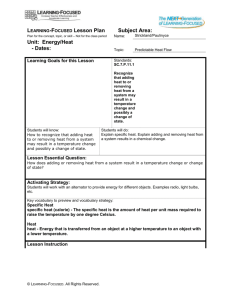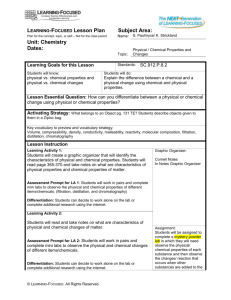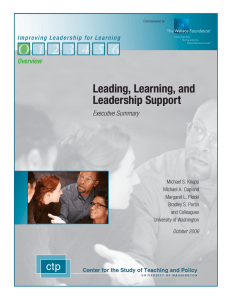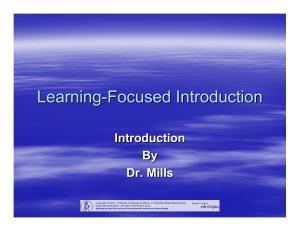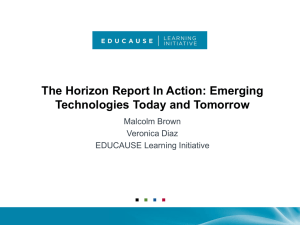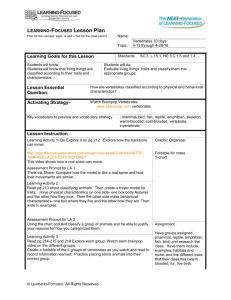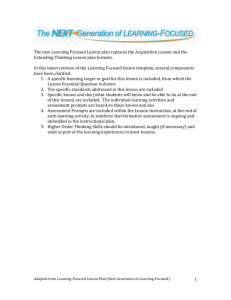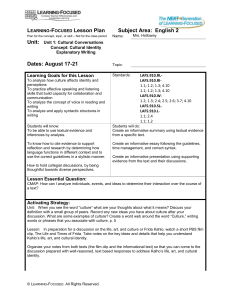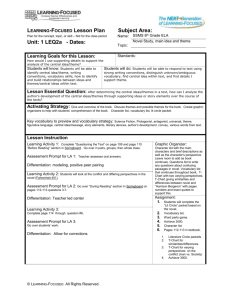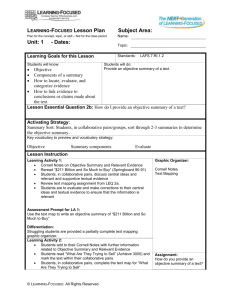Strategies That Most Impact Achievement
advertisement
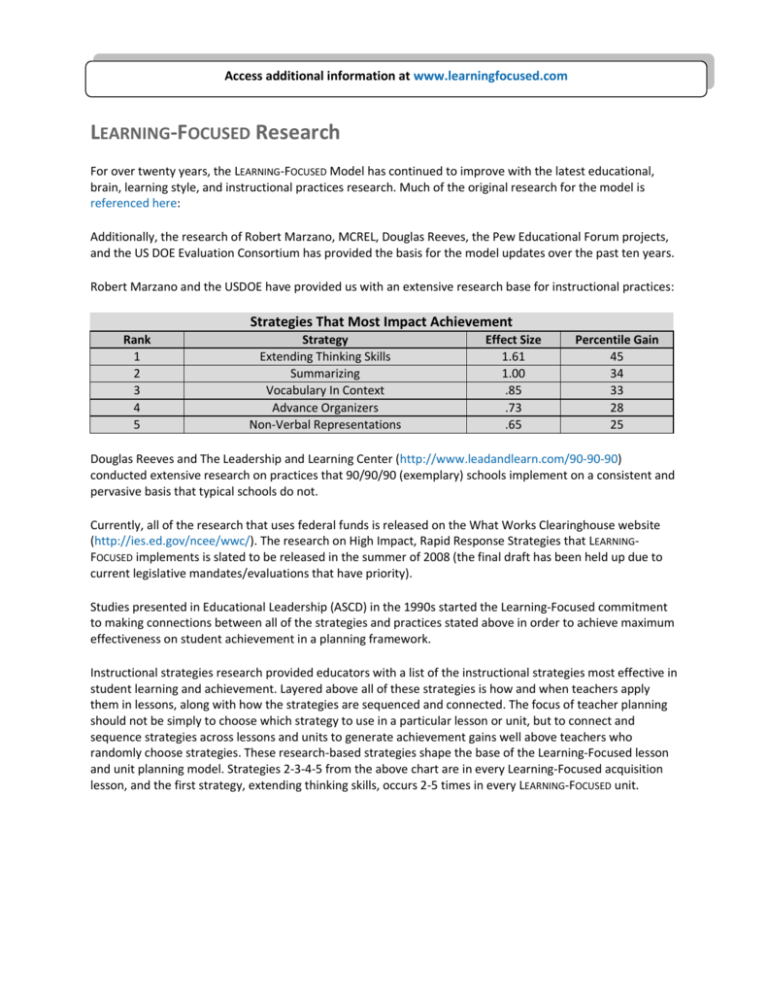
Access additional information at www.learningfocused.com LEARNING-FOCUSED Research For over twenty years, the LEARNING-FOCUSED Model has continued to improve with the latest educational, brain, learning style, and instructional practices research. Much of the original research for the model is referenced here: Additionally, the research of Robert Marzano, MCREL, Douglas Reeves, the Pew Educational Forum projects, and the US DOE Evaluation Consortium has provided the basis for the model updates over the past ten years. Robert Marzano and the USDOE have provided us with an extensive research base for instructional practices: Strategies That Most Impact Achievement Rank 1 2 3 4 5 Strategy Extending Thinking Skills Summarizing Vocabulary In Context Advance Organizers Non-Verbal Representations Effect Size 1.61 1.00 .85 .73 .65 Percentile Gain 45 34 33 28 25 Douglas Reeves and The Leadership and Learning Center (http://www.leadandlearn.com/90-90-90) conducted extensive research on practices that 90/90/90 (exemplary) schools implement on a consistent and pervasive basis that typical schools do not. Currently, all of the research that uses federal funds is released on the What Works Clearinghouse website (http://ies.ed.gov/ncee/wwc/). The research on High Impact, Rapid Response Strategies that LEARNINGFOCUSED implements is slated to be released in the summer of 2008 (the final draft has been held up due to current legislative mandates/evaluations that have priority). Studies presented in Educational Leadership (ASCD) in the 1990s started the Learning-Focused commitment to making connections between all of the strategies and practices stated above in order to achieve maximum effectiveness on student achievement in a planning framework. Instructional strategies research provided educators with a list of the instructional strategies most effective in student learning and achievement. Layered above all of these strategies is how and when teachers apply them in lessons, along with how the strategies are sequenced and connected. The focus of teacher planning should not be simply to choose which strategy to use in a particular lesson or unit, but to connect and sequence strategies across lessons and units to generate achievement gains well above teachers who randomly choose strategies. These research-based strategies shape the base of the Learning-Focused lesson and unit planning model. Strategies 2-3-4-5 from the above chart are in every Learning-Focused acquisition lesson, and the first strategy, extending thinking skills, occurs 2-5 times in every LEARNING-FOCUSED unit. Is the LEARNING-FOCUSED Model evidenced-based? There have been several independent analyses conducted to provide evidence of the effectiveness of the LEARNING-FOCUSED Model. These meet the criteria set by the US DOE for “evidence-based blind studies”. A few of the analyses have looked at individual schools, while others have examined data across many schools, and another one examined the data by individual teachers. Study 1: The largest study concerned 57 schools across 4 school districts in 3 different states. All of the teachers were trained in the 2003 – 2004 school year on the following LEARNING-FOCUSED strategies: Prioritize and map the curriculum LEARNING-FOCUSED lessons and units Acceleration and Scaffolding with students with disabilities and at-risk learners Reading comprehension strategies and reading assignments LEARNING-FOCUSED Math The range of the schools’ student populations: 63% - 89% Eligible for Free/Reduced Meals 47% - 63% African-American 20% - 50% Caucasian 12% - 46% Hispanic Average Percentage of Students Meeting or Exceeding Standards 57 Schools - 4 Districts - 3 States Reading All Black Hispanic White SWD Econ Dis. Math All Black Hispanic White SWD Econ Dis. LEARNING-FOCUSED Training 2004 66.0% 56.0% 59.2% 74.0% 53.7% 65.0% 2004 56.0% 44.0% 46.1% 66.0% 50.3% 54.0% LEARNING-FOCUSED in all classrooms 2005 76.0% 72.0% 71.3% 78.0% 71.0% 74.0% 2005 70.0% 65.0% 66.2% 73.0% 62.0% 69.0% 2006 84.4% 83.3% 82.6% 85.3% 82.4% 81.8% 2006 79.8% 71.2% 84.9% 86.3% 79.1% 78.0% 2 Year Gain 18.4% 27.3% 23.4% 11.3% 28.7% 16.8% 2 Year Gain 23.8% 27.2% 38.8% 20.3% 28.8% 24.0% Study 2: Three regional area educational service agencies analyzed the Learning-Focused Model by looking at student test data by individual teachers across a total of 43 schools. Because of the number of teachers, LFS professional development took place in cohorts across three years. Data was examined in the first full year of teaching after the training for each cohort. Data was reported by percentage gain on previous year’s tests for each teacher. Percent Gains On State Tests Grades 3-5: 393 Teachers Reading Math Social Studies Science Cohort 1 27% 23% 19% 25% Cohort 2 24% 20% 24% 21% Cohort 3 30% 27% 24% 26% Grades 6-8: 268 Teachers Reading Math Social Studies Science Cohort 1 21% 17% 22% 20% Cohort 2 22% 18% 23% 20% Cohort 3 24% 23% 22% 25% Grades 9-12: 234 Teachers Reading Math Social Studies Science Cohort 1 20% 14% 20% 21% Cohort 2 18% 16% 23% 21% Cohort 3 22% 16% 24% 22% Study 3: An Individual School Demographics: 1479 students on February 1, 2007 39 new teachers in 2006 – 2007 school year Students: African-American: 20%; Asian: 8%; Caucasian: 3%; Hispanic: 65% 92% eligible for Free/Reduced Meals 75% of students do not have English as native language 54% served in ESOL program 601 of the 2006-2007 students were at this school in 2005-2006 Only 15% of 2006-2007 5th graders attended this school in 1st grade 50%+ mobility rate Monitoring/Evaluation (EVERY Classroom) 1. LEARNING-FOCUSED unit with Student Learning Maps guiding and structuring learning and LEARNINGFOCUSED lesson plan 2. Only grade-level content in all classrooms 3. Monthly focus on reading comprehension strategies 4. Graphic Organizers USED for writing, reading comprehension 5. Extended reading passages for all students 6. Collaborative planning time using the Learning-Focused planning model 7. Student Writing samples posted and extended writing response on answering essential questions The results of implementing Learning-Focused? 2005/2006 School Year Percent Passing State Tests: All Black Hispanic ESL SWD Economically Disadvantaged Reading/Language 85% 88% 81% 77% 67% 84% Math 91% 90% 91% 88% 84% 93% 2006/2007 School Year Percent Passing State Tests: All Black Hispanic ESL SWD Economically Disadvantaged Reading/Language 91% 92% 93% 83% 81% 91% SWD = +30 in Reading in 3 years; +45 in Math in 3 years LEP = +31 in reading in 3 years; +44 in Math in 3 years All other subgroups at least +15 Met AYP in all sub-groups last 4 years Math 96% 95% 96% 96% 94.7% 96%
